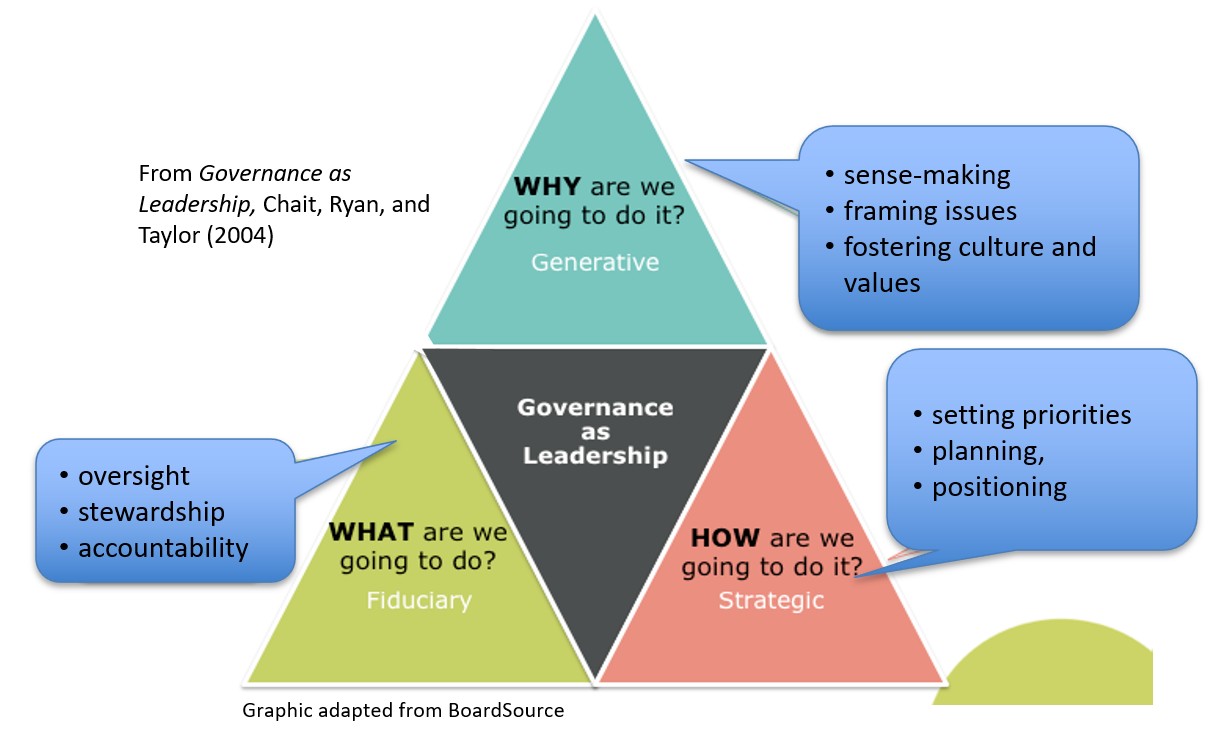The Building Blocks of Good Governance: Fiduciary, Strategic, Generative Modes in Action
Board service is often described as oversight. But oversight comes in more than one flavor. In their seminal book Governance as Leadership, Richard Chait, William Ryan, and Barbara Taylor describe three complementary modes of governance: fiduciary, strategic, and generative.
Strong boards learn to move fluidly among these modes, depending on the time of year and the tasks that might be in front of them, asking different kinds of questions depending on the situation.
 The Three Modes of Governance
The Three Modes of Governance
FIDUCIARY: Stewardship and Accountability. The fiduciary mode is the one most boards unfortunately spend most of their time because it is the most tangible and accessible. The fiduciary mode is by far the most operational-minded. Here, boards safeguard assets, ensure compliance, and monitor accountability. The core questions are: “Are we following the rules? Are we using resources wisely?”
This mode includes reviewing budgets, approving audits, monitoring risks, and ensuring policies are in place. Fiduciary work is essential; without it, the lights don’t stay on. But it is only the beginning of healthy governance.
STRATEGIC: Direction and Positioning. In strategic mode, boards shift from stewardship to guidance. They set priorities, align resources, and position the organization for long-term success. The core questions are: “Where are we going? How do we get there?”
Strategic work includes approving strategic plans, considering competitive positioning, allocating resources, and partnering with leadership on big-picture priorities. It is about making choices that matter for the organization’s future.
GENERATIVE: Sense-Making and Purpose. Generative mode is often the least familiar, but it is what makes governance come alive. In this mode, boards frame problems, interpret meaning, and ground decisions in mission and values. The core questions are: “Who are we? What do we stand for? How do we frame meaning?”
Generative work includes asking bold questions, testing assumptions, and shaping culture. It shifts conversations from “what should we approve?” to “what does this mean for who we are becoming?”
A Sorting Activity for Trustees
This is a very simple activity that can be done at any board meeting to help trustees think about their activities and help them shape what they should be focused on. Present them with this list of 10 practices of effective boards and ask them to sort them into generative, strategic, or fiduciary mode activities.
- Recruit mission-aligned members with varied perspectives
- Cultivate a strong head–board partnership
- Conduct regular self-evaluations
- Utilize committees effectively
- Commit to continuous board learning
- Plan for leadership succession
- Make mission-centered decisions
- Steward finances and philanthropy
- Foster inquiry and respectful debate
- Practice strategic thinking over operations
The “answer key” might look like this:
- Fiduciary: 3, 4, 8
- Strategic: 2, 6, 10
- Generative: 1, 5, 7, 9
The exercise works not because the answers are fixed, but because the discussion highlights how governance requires shifting lenses. Trustees often discover that items could live in more than one mode, which underscores that healthy boards move fluidly among all three.
A lagniappe exercise I often challenge boards to undertake is coding the different parts of a board meeting to each of the three modes. You can do this with the agenda or in the meeting by measuring how much time you are spending in each of the three modes. If you find yourself stuck in fiduciary all the time, you probably have an overly operational board!
Bringing Generative Work into Every Meeting
Even when boards understand the modes, generative conversations can easily get crowded out by reports and decisions. The remedy is to embed a single generative question into every agenda. These questions don’t need to be long, but they do need to spark reflection and dialogue.
A helpful way to plan them is as a pattern across the year, so that the board’s sense-making builds on itself. Within the MISBO board, we have adopted this approach for the five meetings we have annually and our sequence looks like this:
1. Provocation & Permission to Rethink (August). We kick off the year by encouraging bold thinking and conversation. Our sample questions are:
- What are our sacred cows, and do we need to send some of them to market?
- What are we pretending not to know?
2. Deep Dive: Long-Term Relevance (October). In our second meeting of the year, we have a little more time available, so we try to focus on enduring value. Here are sample questions:
- If we disappeared tomorrow, what would our members miss most; and what might they not even notice?
- How must we evolve so that we still matter in 2030?
3. Deep Dive: Capacity & Investment (January). Our winter meeting is also a little longer, so we have more time to challenge assumptions about resources and readiness. Below are some sample questions that fit this part of our cycle:
- What are we under-building for the future?
- What can we stop doing to free up the energy we need for what’s next?
4. Course Check & Culture (April). Our spring meeting is a little shorter, so we try to be more tactical and pause to examine subtle shifts in mission or culture. We might ask one of the following:
- Where are we drifting, slowly enough that we haven’t noticed yet?
- Where have we gotten lucky, and are we mistaking that for strategy?
5. Closure & Renewal (June). In our last meeting of the year, we end with reflection and preparation for what’s next by asking something like:
- What’s one belief we’ve strengthened this year and one belief we should reconsider before next year?
- What did we learn this year that we’ll carry forward and what are we ready to leave behind?
This pattern gives trustees a rhythm of provocation, relevance, capacity, culture, and renewal. Ideally, we spend about 20 minutes discussing in small group and 10 minutes in whole group. Giving the question ahead of time so the board can reflect on it has proven critical and we find that we have to cut off conversation with board members wanting to talk about it more. Intentionally practicing generative thinking elevates all the other work of the board.
The most meaningful part of board service is not voting on budgets or a tuition increase, or, heaven help us, a dress code change (I'm not sure it could count as fiduciary it is so operational and really doesn’t have a place in a board meeting!), but rather engaging in enduring questions like these. Fiduciary and strategic work ensure the organization functions and grows, and generative work keeps it anchored in purpose.
If you are interested in a board workshop, more information is here.

